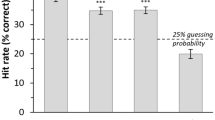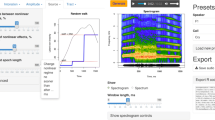Abstract
Human laughter vocalizations are composed of highly variable sounds. We investigated the evaluation of laughter sounds and concentrated especially on the role of two acoustic features of laughter series: specific rhythms and changes in the fundamental frequency. Experimentally modified laughter series were evaluated using listener self-report data. Participants evaluated laughter series with differences in duration (Experiment 1), or in duration and frequencies (Experiment 2) of successive elements. Serial patterns with varying parameters received good ratings that were close to those received for natural laughter. By contrast, series with a stereotyped patterning received poor ratings. In addition, we found that self-report data strongly correlated to participants' direct behavioral reactions while listening to a specific stimulus. We suggest a three-part model to describe mechanisms underlying the evaluation of laughter.
Similar content being viewed by others
References
Bachorowski, J.-A., & Owren, M. J. (2001). Not all laughs are alike: Voiced but not unvoiced laughter readily elicits positive affect. Psychological Science, 12, 252–257.
Bachorowski, J.-A., Smoski, M. J., & Owren, M. J. (2001). The acoustic features of human laughter. Journal of the Acoustic Society of America, 110, 1581–1597.
Bortz, J., Lienert, G. A., & Böhnke, K. (1990). Verteilungsfreie Methoden in der Biostatistik, (Nonparametric methods in biostatistics). Berlin: Springer Verlag.
Collier, W. G., & Hubbard, T. L. (2001). Judgements of happiness, brightness, speed and tempo change of auditory stimuli varying in pitch and tempo. Psychomusicology, 17, 36–55.
Darwin, C. (1872). The expression of emotion in man and animals. London: Murray.
Devereux, P. G., & Ginsburg, G. P. (2001). Sociality effects on the production of laughter. Journal of General Psychology, 128, 227–240.
Echols, C. H., Crowhurst, M. J., & Childers, J. B. (1997). The perception of rhythmic units in speech by infants and adults. Journal of Memory and Language, 36, 202–225.
Edmonson, M. S. (1987). Notes on laughter. Anthropological Linguistics, 29, 23–33.
Ekman, P., Friesen, W., O'Sullivan, M., & Scherer, K. R. (1980). Relative importance of face, and speech in judgements of personality and affect. Journal of Personality and Social Psychology, 38, 270–277.
Gabrielsson, A. (1987). Action and perception in rhythm and music. Stockholm: Royal Swedish Academy of Music.
Grammer, K. (1990). Strangers meet: Laughter and non-verbal signs of interest in opposite-sex encounters. Journal of Nonverbal Behavior, 14, 209–236.
Grammer, K., Filova, V., & Fieder, M. (1997). The communication paradox and possible solutions. Towards a radical empiricism. In A. Schmitt, K. Atzwanger, K. Grammer, & K. Schäfer (Eds.), New aspects of human ethology (pp. 91–120), New York: Plenum Press.
Guerkan-Tekman, H. (2002). Perceptual integration of timing and intensity variations in the perception of musical accents. Journal of General Psychology, 129, 181–191.
Hall, G. S., & Allin, A. (1897). The psychology of tickling, laughing, and the comic. American Journal of Psychology, 9, 1–41.
Houtsma, A. J. M. (1995). Pitch perception. In B. C. J. Moore (Ed.), Handbook of perception and cognition: Hearing (2nd ed., pp. 267–295). San Diego: Academic Press.
Kämmerer, R. (1996). Die kommunikative Bedeutung von Parametervariationen in homotypen Signalserien: Modelle menschlicher Lachepisoden. [The communicative meaning of parameter variation within homotype signal series: The model of human laughter]. Unpublished Diploma Thesis, Free University Berlin, Germany.
Kipper, S., Kämmerer, R., & Todt, D. (1999). Experimental access to acoustic features in human laughter perception. Advances in Ethology (Suppl. to Ethology), 34, 38.
Kipper, S., & Todt, D. (2001). Variation of sound parameters affects the evaluation of human laughter. Behaviour, 138, 1161–1178.
Kipper, S., & Todt, D. (2002). The use of vocal signals in the social play of Barbary macaques. Primates, 43, 3–17.
Kipper, S., & Todt, D. (2003). Dynamic-acoustic variation causes differences in evaluations of laughter. Perceptual and Motor Skills, 96, 799–809.
Martin, J. G. (1972). Rhythmic (hierarchical) versus serial structure in speech and other behaviors. Psychological Review, 79, 487–509.
Martin, R. A., & Kuiper, N. A. (1999). Daily occurrence of laughter: Relationships with age, gender, and Type A personality. HUMOR-International Journal of Humor Research, 12, 355–384.
McConnell, P. B., & Baylis, J. R. (1985). Interspecific communication in cooperative herding: Acoustic and visual signals from shepherds and herding dogs. Zeitschrift für Tierpsychologie, 67, 302–328.
McGregor, P. K. (1992). Quantifying responses to playback: one, many, or composite multivariate measures? In P. K. McGregor (Ed.), Playback and Studies of Animal Communication (pp. 79–96). New York: Plenum Press.
Mowrer, D. E. (1994). A case study of perceptual and acoustic features of an infant's first laugh utterances. HUMOR—International Journal of Humor Research, 7, 139–155.
Mowrer, D. E., LaPointe, L. L., & Case, J. (1987). Analysis of five acoustic correlates of laughter. Journal of Nonverbal Behavior, 11, 191–199.
Nwokah, E. E., Davies, P., Islam, A., Hsu, H. C., & Fogel, A. (1993). Vocal affect in the three-year-olds: A quantitative acoustic analysis of child laughter. Journal of the Acoustic Society of America, 94, 3076–3090.
Nwokah, E. E., Hsu, H. C., Davies, P., & Fogel, A. (1999). The integration of laughter and speech in vocal communication: A dynamic systems perspective. Journal of Speech, Language, and Hearing Research, 42, 880–894.
Pittam, J., & Scherer, K.R. (1993). Vocal expression and communication of emotion. In M. Lewis, & J. M. Haviland (Eds.), Handbook of emotions (pp. 185–197). New York: Guildford.
Provine, R. R. (1992). Contagious laughter: Laughter is a sufficient stimulus for laughs and smiles. Bulletin of the Psychonomic Society, 30, 1–4.
Provine, R. R. (2000). Laughter. A scientific investigation. London: Faber and Faber.
Provine, R. R., & Fischer, K. R. (1989). Laughing, smiling and talking: Relation to sleeping and social contexts in humans. Ethology, 83, 295–305.
Provine, R. R., & Yong, Y. L. (1991). Laughter: A stereotyped human vocalization. Ethology, 89, 115–124.
Rothgänger, H., Hauser, G., Cappellini, A. C., & Guidotti, A. (1998). Analysis of laughter and speech sounds in Italian and German students. Naturwissenschaften, 85, 394–402.
Ruch, W., & Ekman, P. (2001). The expressive pattern of laughter. In A.W. Kaszniak (Ed.), Emotion, qualia and consciousness (pp. 426–443). Tokyo: World scientific publisher.
Scharlemann, J. P. W., Eckel, C. C., Kacelnik, A., & Wilson, R. K. (2001). The value of a smile: Game theory with a human face. Journal of Economic Psychology, 22, 617–640.
Siegel, S., & Castellan, N. J. (1988). Nonparametric statistics for the behavioral sciences. McGraw-Hill Book Company.
ten Hoopen, G., Hartsuiker, R., Sasaki, T., Nakajima, Y., Tanaka, M., & Tsumura, T. (1995). Auditory isochrony: Time shrinking and temporal patterns. Perception, 24, 577–593.
Todt, D. (1988). Serial calling as a mediator of interaction processes: Crying in primates. In D. Todt, P. Goedeking, & D. Symmes (Eds.), Primate vocal communication (pp. 88–103). Berlin: Springer Verlag.
Todt, D. (1997). The codex of social play: A system of rules that can prevent ingroup violence. In M. Gruter & M. Rehbinder (Eds.), Gewalt in der Kleingruppe und das Recht [Violence in small groups and the law] (pp. 305–313). Bern: Stämpfli Verlag AG.
Todt, D., & Kipper, S. (2001). Studien zum Lachverhalten. Ein Einblick in verhaltensbiologische Forschungen. [Studies on laughter: An introduction into research in behavioral biology]. Pädagogik, 9, 30–34.
Todt, D., & Kipper, S. (2003). Der Begriff Kommunikation in den Biowissenschaften [The concept of communication in the biological sciences]. In H. Richter & H. W. Schmitz (Eds.), Kommunikation—ein Schlüsselbegriff der Humanwissenschaften? Münster: Nodus Publikationen.
Trainor, L. J., Austin, C. M., & Desjardins, R. N. (2000). Is infant-directed speech prosody a result of the vocal expression of emotion? Psychological Science, 11, 188–195.
Vaid, J., & Kobler, J. B. (2000). Laughing matters: Toward a structural and neural account. Brain and Cognition, 42, 139–141.
Vettin, J., & Todt, D. (2003). Laughter in converstation: Features of occurrence and acoustic structure. Manuscript submitted for publication.
Vettin, J., Skirl, J., & Todt, D. (1999). From social play to tickling and laughter: A comparative approach. Advances in Ethology (Supplement to Ethology), 34, 37.
Warren, R. M. (1982). Auditory perception: A new synthesis. New York: Pergamon Press.
Werker, J. F., & McLeod, P. J. (1989). Infant preference for both male and female infantdirected talk: A developmental study of attentional and affective responsiveness. Canadian Journal of Psychology, 43, 230–246.
Wiedenmann, G., & Todt, D. (1990). Discrete responses of adult subjects during exposure to infant cry sequences. Early Child Development and Care, 65, 179–188.
Author information
Authors and Affiliations
Corresponding author
Rights and permissions
About this article
Cite this article
Kipper, S., Todt, D. The Role of Rhythm and Pitch in the Evaluation of Human Laughter. Journal of Nonverbal Behavior 27, 255–272 (2003). https://doi.org/10.1023/A:1027384817134
Issue Date:
DOI: https://doi.org/10.1023/A:1027384817134




